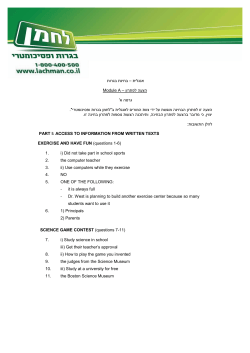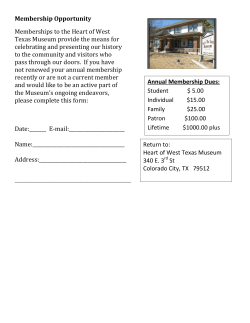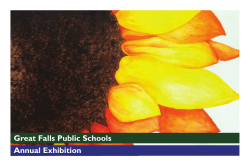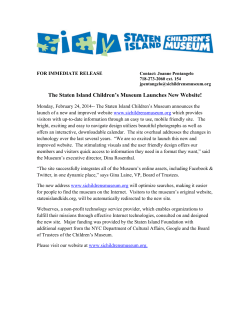
NATIONAL ROAD MUSEUM - National Road Heritage Foundation
NATIONAL ROAD MUSEUM C O M M E M O R AT I N G T H E R O A D T H AT L E D T O A M E R I C A’ S F U T U R E The National Road Museum will honor the nation’s first federal highway intended to expand and populate America’s untamed west. H The National Road paved the way for hundreds of thousands of industrious emigrants, whose search for a better life spurred economic growth and helped to unify our fledgling nation. H The museum will be a dynamic place for discovery and imagination, sparking a passion for American history. Historic Boonsboro photos courtesy Doug Bast History Constructed from 1811 to 1834, linking Maryland to Illinois, the road was designed to help stabilize our young nation through westward expansion. A dynamic corridor for the movement of people and goods, towns and villages emerged in its path, catering to the needs of those forging farther west. Today, the National Road offers a vibrant and scenic 620 mile byway with historic inns, motels, diners, tollhouses, and bridges that provides tangible sevidence of its role in more than 300 years of American history. Museum The intriguing story of the National Road Museum will be presented through such themes as, “The National Road Overview,” “Road Origins,” “National Road Engineering Commerce and Transportation,” “Vehicles Through Time,” “Civil War Logistics,” and “Pike Towns,” using photographic murals, maps, artifacts, historic images, artwork, outdoor paving models, and compelling video. Location With its 19th century row of preserved main street structures, Boonesboro offers the ideal site for the National Road Museum. Located at a historic crossroads, travelled by America’s earliest pioneers, courageous Union and Confederate troops, as well as the nation’s first motorists, the National Road Museum is just minutes from such historic sites as Antietam National Battlefield, C&O Canal Towpath, Harpers Ferry Historical Park, South Mountain, and more. Like the National Road, the museum facility will attract additional visitors to eastern Washington County and will expand regional tourism. Conceptual digital models of gallery spaces. M a r ke t i n g The Maryland Office of Tourism promotes Maryland’s Scenic Byways and the Civil War Heritage Area through its broad marketing efforts and visitor programming, which includes: • Facebook, YouTube and Twitter The National Road Museum, will be the only museum in Maryland dedicated to this historic highway. It is located on the actual historic road, which is a Maryland Scenic Byway and has been designated by the Federal Highway Administration USDOT as an All-American Road (a National Scenic Byway). Preservation and Economic Development The Maryland Heritage Area Program (MHAP) promotes economic activity by protecting historic areas and fostering heritage tourism. A 2003 study found that the investment of $3.6 million in grants and $8.9 million in total development costs dedicated to Maryland’s seven oldest heritage areas returned $4.61 on the dollar. During the same period the state also gained nearly 3,400 jobs and almost $17 million in annual state and local tax receipts. The National Road Museum is located within Maryland’s Civil War Heritage Area and in close proximity to three National Park Service sites, which will generate higher regional economic impact. NATIONAL ROAD HERITAGE FOUNDATION www.nationalrdfoundation.com H PO Box 71, Boonsboro MD 21713 • Mobile apps that complement and enhance the visitor experience • Maryland on the Road Enterprises (MORE), a state program to promote group travel The National Road Museum website will feature videos, oral histories, photographs, artifact overviews as well as discussions with experts about the importance of one of America’s earliest highways. The use of social media and mobile apps as part of the museum experience will allow the public to exchange commentary, opinions, and ideas that will make the museum and its messages even more dynamic. Visitors will be encouraged to share their own personal National Road photos and experiences. Today’s modern traveler uses technology to plan, reserve, experience and share their visits with others. Technologies such as Google, Facebook, YouTube, and Twitter will play a major role in the marketing of the museum.
© Copyright 2025









